Introduction to Biofuels
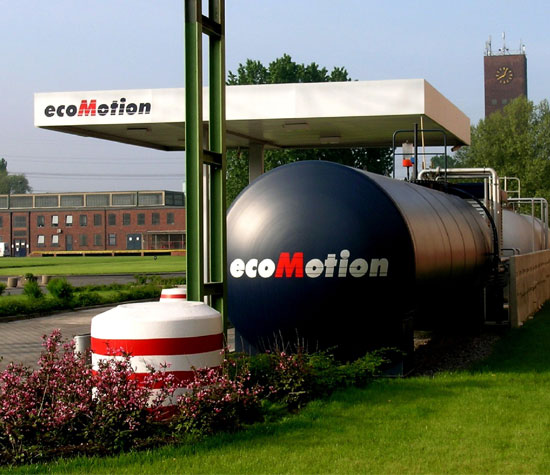
A biodiesel filling station (JosefLehmkuhl, Wikimedia Commons)

A biodiesel filling station (JosefLehmkuhl, Wikimedia Commons)
How does this align with my curriculum?
Learn about biofuels and what makes them a promising alternative to fossil fuels.
Have you ever used a laptop, ridden in a car, or switched on a light? or a smartphone? If you answered “yes” to any of these questions, you have used energy. Life would not be as we know it without energy. As the world’s population grows, people will need more and more energy. But how do we meet this need in a sustainable way?
Since the Industrial Revolution, most of the energy we use has come from burning fossil fuels. The amount of energy we produce by burning fossil fuels has been about the same for the past 30 years. As of 2022, about 80% of the world’s energy came from burning fossil fuels. But fossil fuels are not the only source of energy. We can get energy from renewable sources such as the wind, the Sun and moving water. We can also get energy from plant-based products. We call these biofuels or bioenergy.
Did you know?
As of 2022, biofuel accounts for approximately 6% of the total amount of energy used globally.
What’s the difference between fossil fuels and biofuels?
Fossil fuels are solid, liquid or gaseous forms of hydrocarbons. Hydrocarbons are compounds made of hydrogen and carbon.
Fossil fuels come from plants and animals that lived on Earth millions of years ago. Over time, heat and pressure turned this material into fossil fuels. Coal is a type of fossil fuel made from sedimentary rock deposits containing dead plants and animals.
Did you know?
Fossilized plants make up more than 50 percent of the weight of a piece of coal.
What is biofuel and how is it used?
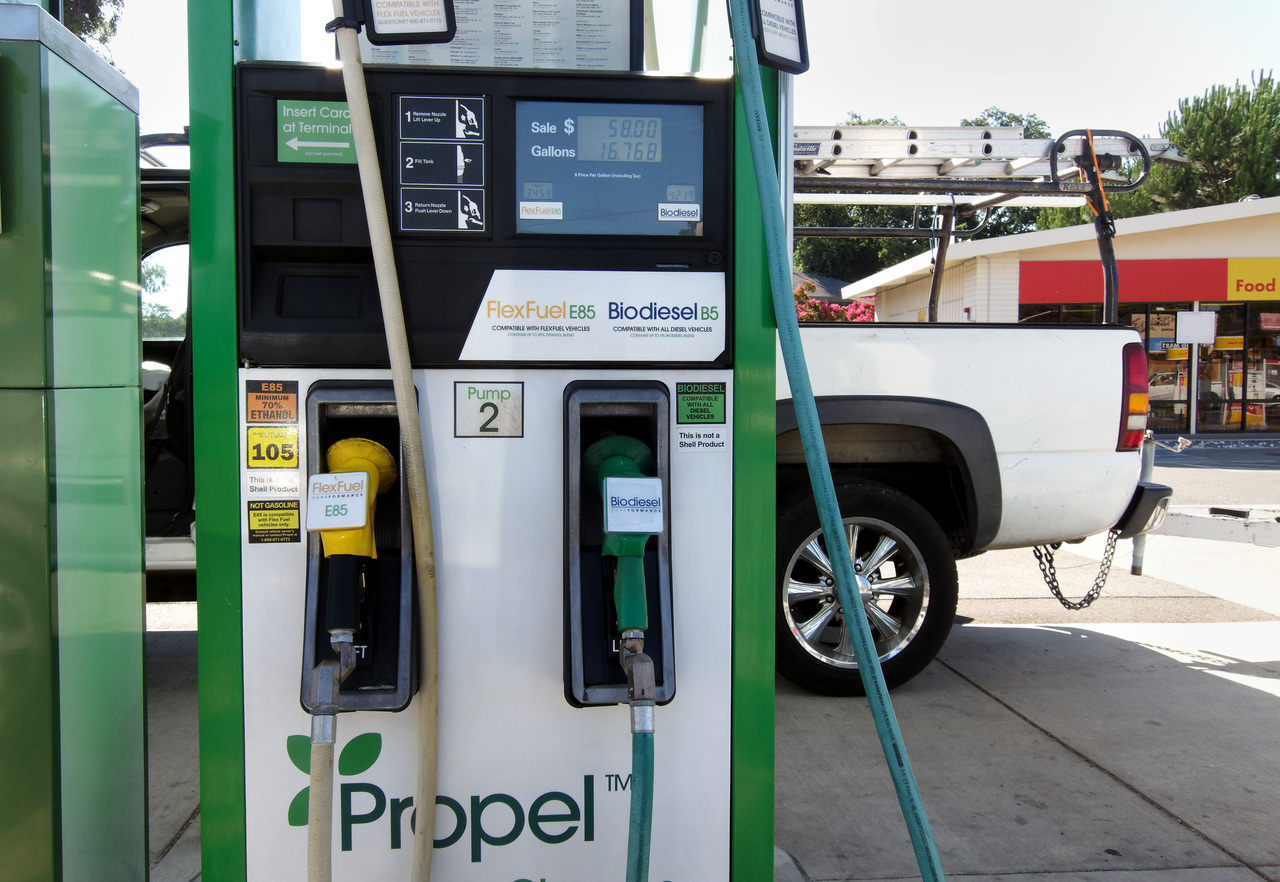
Biofuel pump at a gas station (Source: Robert Couse-Baker [CC BY 2.0] via pxhere).
Image - Text Version
Shown is a colour photograph of a biofuel pump at a filling station.
On the left of the pump is a yellow nozzle. The label for the nozzle indicates that it is for E85 fuel. This fuel has 85% ethanol in the fuel. To the right of this is a green nozzle. The label for this nozzle indicates that it is for biodiesel fuel. Behind the pump the back end of a white truck is partly visible and further back is the side of a gas station.
Did you know?
The concept of using biofuels has been around since the 1800s! Henry Ford believed that ethanol would be the fuel of the future.
What are biofuels made of?
Scientists divide biofuels into four categories or generations. Each generation is defined by its feedstock.
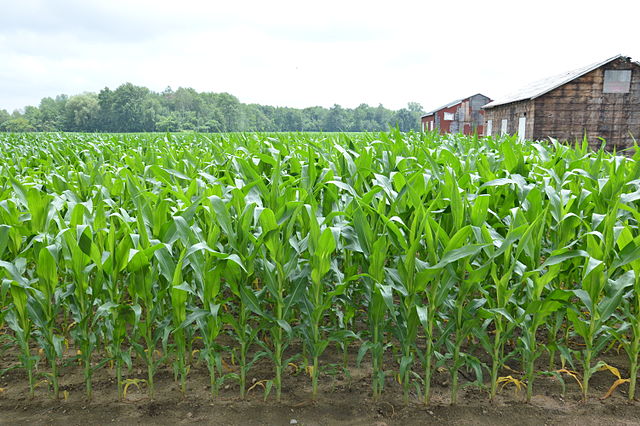
Corn field in Ontario (Source: Illustratedjc [CC BY-SA 3.0]via Wikimedia Commons).
Image - Text Version
Shown is a colour photo of a corn field. Young corn stalks grow in dense green rows across a large field. There are two farm houses staggered one behind the other in the far right corner, and a forest in the centre background. A clear day with hints of blue sky and white clouds at the very top of the image.
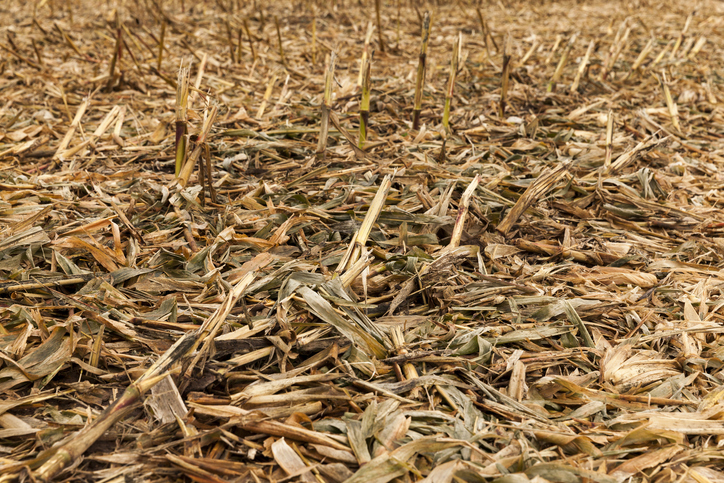
Corn crop residue (ligora via iStockphoto).
Image - Text Version
Broken and dried corn stalks lay in a beige brown mat in the field. Short stalk residues stick up in different directions off the ground.
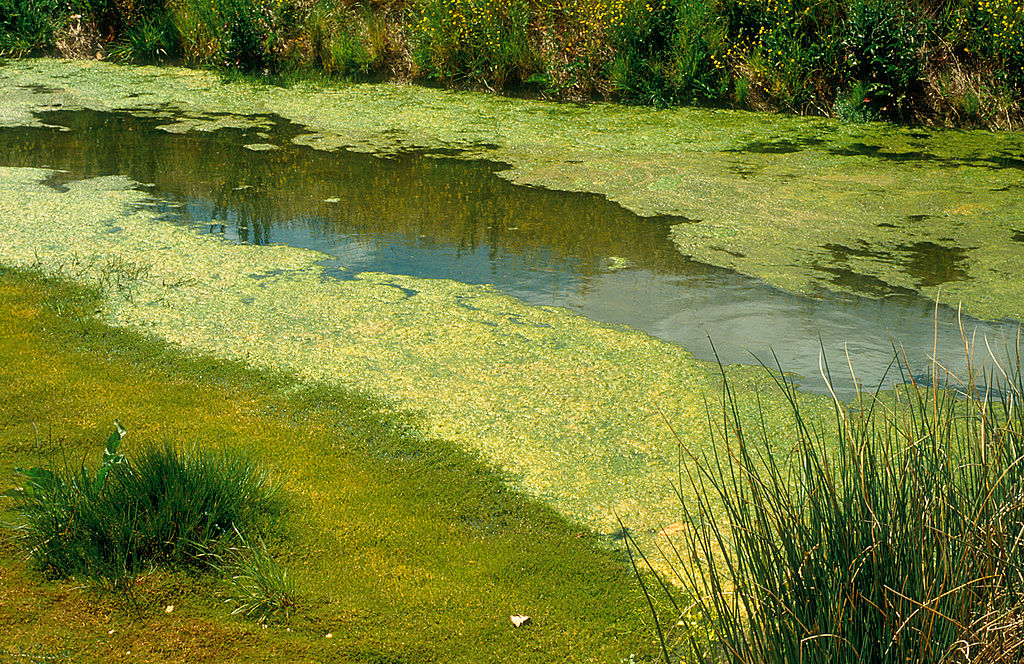
Blue green algae on a river (Source: CSIRO [CC BY] via Wikimedia Commons).
Image - Text Version
Shown is a colour photo of blue green algae blooming on opposite sides of a river.
In the centre is a narrow river. The water reflects blue sky and green trees in between the blooms of pale yellowish algae. In the foreground is a group of tall grass on the right and a small stretch of green grass on the left. On the far side of the river bank, green shrubbery with small yellow flowers grow.
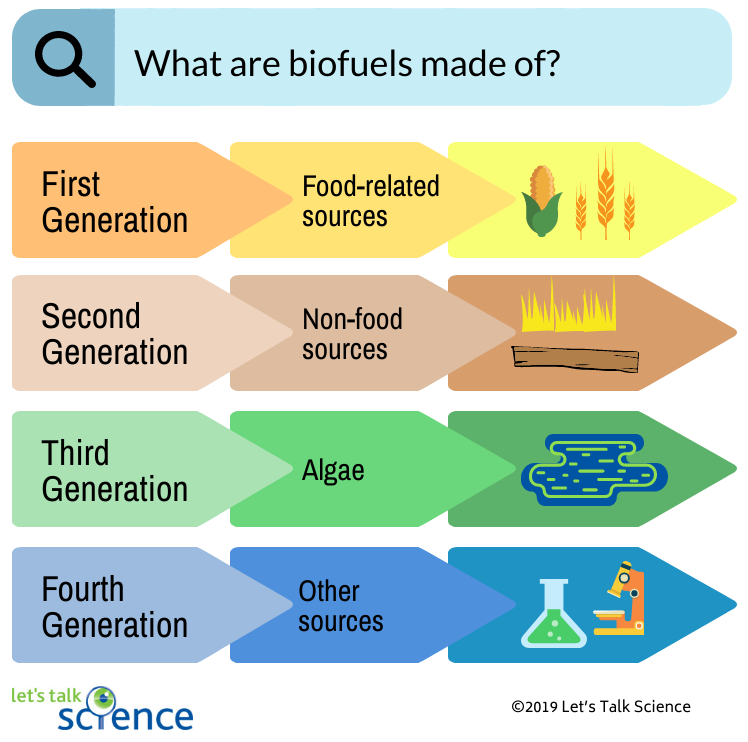
Summary of the four generations of biofuels (©2019 Let’s Talk Science).
Image - Text Version
Shown is a colour flowchart which provides a summary of the four generations of biofuels. Colourful blocks with arrows are arranged in four rows and 3 columns. The last column shows an image example for each source.
First-generation biofuels come from food-related sources, like starch from corn and wheat. Second-generation biofuels come from non-food sources like cellulose and wood fibres. Third-generation biofuels come from algae. Fourth-generation biofuels come from other sources (lab equipment is shown as an example).
Ethanol
Ethanol is one of the two main types of biofuel. Corn is the main feedstock used to make ethanol in North America. In order to make ethanol corn is ground up and then cooked. Chemical processes then break down the starch in the corn into simple sugars. Yeast breaks down the sugars to form alcohol.
Did you know?
Manufacturers of ethanol biofuel must put in additives at the end so that people cannot drink it!
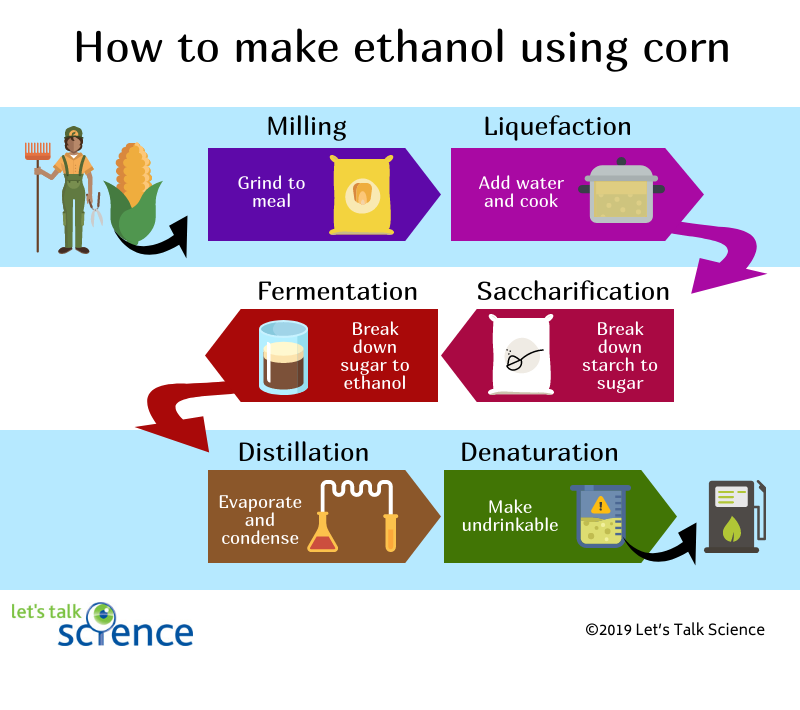
Steps in the ethanol production process (© 2019 Let’s Talk Science).
Image - Text Version
Shown is a colour flowchart showing the steps involved in the ethanol production process. Colourful blocks with extending arrows and example images depict each stage of the process. Beginning of the process is marked by a farmer standing with a rake and yard scissors next to an ear of corn. Steps include milling the corn to meal, liquefying the meal by adding water and cooking, breaking down starch into sugar, using yeast to ferment the sugar to ethanol, distilling the ethanol by boiling off and condensing it by removing residual water and finally denaturing so that it is undrinkable. The end of the process is marked by an image of a gas pump.
Did you know?
A biorefinery is a facility where biomass is converted into biofuel
Canada had 12 operational ethanol plants in 2021. These plants have the ability to produce up to 1.881 billion litres of ethanol per year. As a result of Covid-19, ethanol production is not as high as it could be. Canadian ethanol plants produced an estimated 1.28 billion litres of fuel ethanol in 2021, down slightly from 1.689 billion litres in 2020.
Most of this ethanol is mixed into gasoline. Since the 1980’s, most cars have been built to run on a mixture of up to 10% ethanol. We call this fuel mixture E10. Some car companies make Flexible Fuel, or Flex-Fuel, vehicles with modified engines. These engines can use mixtures of up to 85% ethanol. We call this fuel mixture E85.
Did you know?
In 2022, Canada introduced Clean Fuel Regulations. These regulations require gasoline and diesel suppliers to gradually reduce the amount of pollution from the fuels they produce and sell. The goal is to have a 15% decrease from 2016 levels by 2030.
Biodiesel
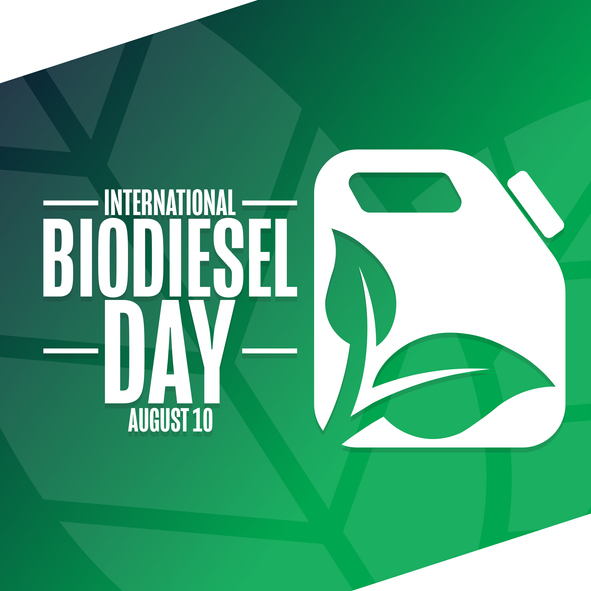
International Biodiesel Day (Source: Bulgnn via iStockphoto).
Image - Text Version
Shown is a colourful logo of International Biodiesel Day on August 10th.
The letters of the logo have bold white block letters and a clip-art image of a gas canister with a green leaf design on the bottom left. The background is mainly green with two overlapping leaves, each tip pointed in the opposite corner of the image. Leaf veins are highlighted by a slightly darker shade of green. Small right-angled triangles are placed in the top left and bottom right corner of the background.
Did you know?
The United States and Brazil are the world leaders in biofuel production.
Why use biofuels instead of fossil fuels?
Fossil fuels are a non-renewable source of energy. This means that if we keep using them, they will run out. Plants, on the other hand, are a renewable source of energy. We can grow plants again and again to make biofuels.
Both fossil fuels and biofuels produce carbon dioxide (CO2) when they are burned. Carbon dioxide is a greenhouse gas that contributes to climate change. However, biofuel is considered to be carbon neutral. This is because the plants used to make ethanol absorb CO2 as they grow. When they are burned, they do not increase overall greenhouse gas levels in the atmosphere.
What is the future of biofuels?
So why isn’t everyone using biofuels? Just like with other fuels, there are some challenges involved with producing biofuels. These include the cost of production and the source of the feedstock. But every day, researchers are finding new ways to make biofuels, which could make production less expensive. And by using plants like algae, producers will not have to use land that could grow the food people need.
It’s probably only a matter of time before vehicles no longer use fossil fuels and are powered by more sustainable fuels like biofuels and hydrogen.
Starting Points
- Have you or anyone you’ve driven with ever filled up the car with ethanol? Why or why not?
- Can you purchase E85 fuel at your local gas station? How often do you see vehicles filling up with ethanol fuel?
- Is it worthwhile for people to invest in cars that can use ethanol fuel? Explain.
- How does the availability of an ethanol fuel option (e.g., E85) at the pump impact the sales and purchases of ethanol option vehicles?
- What are the differences between fossil fuels and biofuels?
- What are the key differences between the four generations of biofuels?
- Conduct research to explore what types of wastes are being used to make second-generation or cellulosic biofuels.
- Using the example of third-generation biofuels, how do interactions between science and technology impact on the progress of developing a biofuels product that can be used in the general marketplace?
- Companies like Exxon have been doing promotional advertising about third-generation algal biofuels in recent years. Why would a company that manufactures and sells traditional fossil fuels be promoting an alternative biofuel? Are there other fuel companies that are doing similar promotional advertising?
- This article can be used to support teaching and learning of Biology and Technology & Engineering related to biofuels, fossil fuels and renewable energy. Concepts introduced include hydrocarbons, biofuels, ethanol, greenhouse gases, carbon dioxide, biodiesel, wind, Sun, renewable, first-generation biofuel, microorganisms, ferment, second-generation biofuels, cellulose, cellulosic biofuels, third-generation biofuels, algae, algal fuels and bioreactors.
- After reading this article, teachers could have students complete a Concept Definition Web learning strategy to consolidate their understanding of the concept of biofuels. Ready-to-use Concept Definition Web reproducibles are available in [Google doc] and [PDF] formats.
Connecting and Relating
- Have you or anyone you’ve driven with ever filled up the car with ethanol? Why or why not?
- Can you purchase E85 fuel at your local gas station? How often do you see vehicles filling up with ethanol fuel?
Relating Science and Technology to Society and the Environment
- Is it worthwhile for people to invest in cars that can use ethanol fuel? Explain.
- How does the availability of an ethanol fuel option (e.g., E85) at the pump impact the sales and purchases of ethanol option vehicles?
Exploring Concepts
- What are the differences between fossil fuels and biofuels?
- What are the key differences between the four generations of biofuels?
- Conduct research to explore what types of wastes are being used to make second-generation or cellulosic biofuels.
Nature of Science/Nature of Technology
- Using the example of third-generation biofuels, how do interactions between science and technology impact on the progress of developing a biofuels product that can be used in the general marketplace?
Media Literacy
- Companies like Exxon have been doing promotional advertising about third-generation algal biofuels in recent years. Why would a company that manufactures and sells traditional fossil fuels be promoting an alternative biofuel? Are there other fuel companies that are doing similar promotional advertising?
Teaching Suggestions
- This article can be used to support teaching and learning of Biology and Technology & Engineering related to biofuels, fossil fuels and renewable energy. Concepts introduced include hydrocarbons, biofuels, ethanol, greenhouse gases, carbon dioxide, biodiesel, wind, Sun, renewable, first-generation biofuel, microorganisms, ferment, second-generation biofuels, cellulose, cellulosic biofuels, third-generation biofuels, algae, algal fuels and bioreactors.
- After reading this article, teachers could have students complete a Concept Definition Web learning strategy to consolidate their understanding of the concept of biofuels. Ready-to-use Concept Definition Web reproducibles are available in [Google doc] and [PDF] formats.
Learn more
Fossil Fuels (2021)
This fact sheet by Hannah Ritchie & Max Roser for Our World in Data contains interactive graphs that describe global fossil fuel consumption.
Bioenergy and Biofuels (2021)
This report from the International Energy Agency contains interactive graphs that have data for global biofuel and bioenergy use.
BiofuelNet Canada Infographics
BiofuelNet Canada has infographics about how different kinds of biofuels are made.
References
Aro, E. (2015). From first generation biofuels to advanced solar biofuels. Ambio, 45, 24-31. DOI: 10.1007/s13280-015-0730-0
IAS Score. (n.d.). Generations of biofuels.
International Energy Agency. (2007, January). IEA energy technology essentials.
National Geographic. (n.d.). Biofuels.
U.S. Energy Information Administration. (2019, February 13). Biofuels: Ethanol and biodiesel explained.